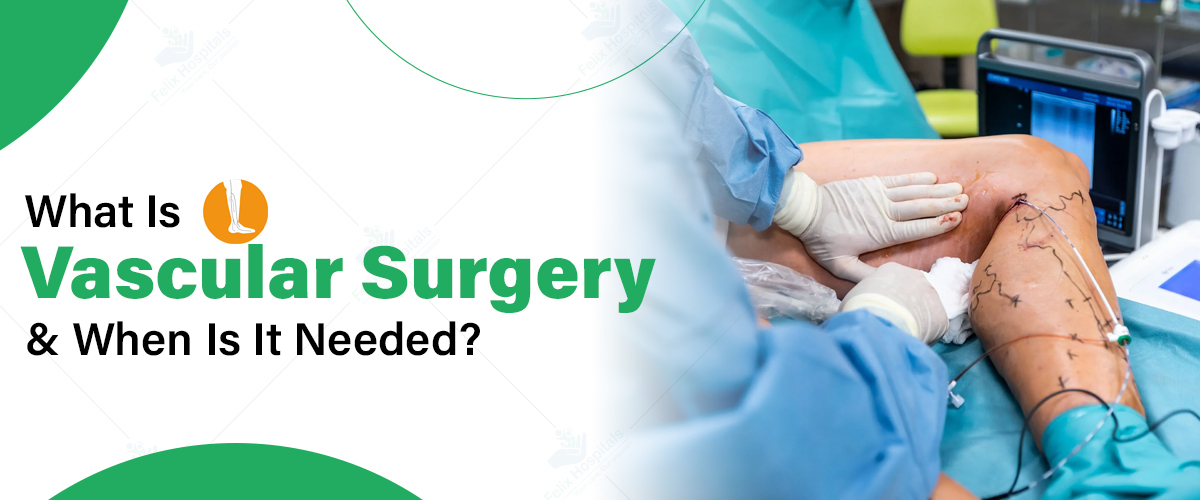
Subscribe to our

Vascular surgery is a specialized branch of surgery that focuses on the diagnosis, management, and treatment of diseases and conditions affecting the blood vessels, including arteries and veins. This field is crucial in addressing vascular conditions that may impact blood flow and, consequently, overall health. Understanding what vascular surgery entails and recognizing when it is needed can be pivotal for maintaining vascular health and preventing severe complications.
Need Expert Advice on Vascular Health? Contact Us Today to Schedule Your Vascular Surgery Consultation - +91 9667064100 .
Vascular Surgery involves surgical procedures designed to treat disorders of the vascular system. This includes the arteries, veins, and lymphatic system. The primary goal of vascular surgery is to restore normal blood flow to affected areas of the body. These procedures may be performed using open surgery techniques or minimally invasive methods, such as endovascular surgery.
1. Aneurysms: An aneurysm is an abnormal bulge in the wall of an artery caused by weakness in the arterial wall. Vascular surgery is often required to repair aneurysms, particularly if they are large or at risk of rupturing.
2. Peripheral Artery Disease (PAD): PAD occurs when the arteries that supply blood to the limbs become narrowed or blocked, leading to pain and impaired mobility. Surgical interventions may include angioplasty or bypass surgery to improve blood flow.
3. Carotid Artery Disease: This condition involves the narrowing of the carotid arteries, which supply blood to the brain. Surgery may be needed to prevent stroke by restoring adequate blood flow to the brain.
4. Varicose Veins: Varicose veins are swollen, twisted veins that can cause discomfort and aesthetic concerns. Surgical treatments, such as vein stripping or endovenous laser therapy, are available to alleviate symptoms and improve appearance.
5. Chronic Venous Insufficiency (CVI): CVI occurs when the veins in the legs cannot effectively return blood to the heart. Surgical options, including vein ablation or sclerotherapy, can help manage this condition.
6. Deep Vein Thrombosis (DVT): DVT is the formation of a blood clot in a deep vein, usually in the legs. In severe cases, surgical interventions such as thrombectomy may be necessary to remove the clot and restore normal blood flow.
The decision to proceed with vascular surgery is based on several factors, including the severity of the condition, the presence of symptoms, and the risk of complications. Vascular Surgery may be indicated in the following scenarios:
1. Significant Symptomatology: If a patient experiences severe symptoms, such as persistent pain, swelling, or ulcers in the affected area, and conservative treatments are ineffective, surgical intervention may be necessary.
2. High Risk of Complications: In cases where vascular conditions pose a significant risk of serious complications, such as stroke or limb loss, surgery may be recommended to mitigate these risks and prevent life-threatening outcomes.
3. Progressive Disease: If a vascular condition is progressing despite medical management and is expected to worsen over time, surgical options may be considered to address the underlying issue and improve long-term outcomes.
4. Failure of Non-Surgical Treatments: When non-invasive treatments, such as medication or lifestyle changes, fail to provide relief or control the condition, surgical options may be explored as a more effective solution.
5. Emergency Situations: In emergency situations, such as a ruptured aneurysm or severe clot, immediate surgical intervention may be required to address the life-threatening nature of the condition and stabilize the patient.
Your health is our priority. Let us help you take the next step toward better vascular health. Call Now for consultancy - +91 9667064100.
Vascular surgery plays a vital role in managing a range of vascular conditions that can impact overall health and quality of life. By understanding the conditions treated by vascular surgery and recognizing when surgical intervention is necessary, individuals can make informed decisions about their vascular health. If you or someone you know is experiencing symptoms or has concerns about vascular health, consulting a qualified Vascular Surgeon is essential for an accurate diagnosis and appropriate treatment plan.